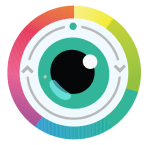
Everything’s going along swimmingly when all of a sudden you start sneezing, your throat feels a bit scratchy, and your eyes get itchy, watery and turn that telltale shade of red. Blergh! Your allergies have struck again. Whether they’re due to furry friends or of the seasonal variety, they’re no fun and it can make wearing contacts uncomfortable. Thankfully, your trusty purveyor of Canadian contact lenses is here to help with our eyeball expertise.
While there are a ton of things that people can be allergic to, we’ve split it into different groups: seasonal/perennial allergies and pet allergies. That’s because having an allergy to dogs or cats, which is technically considered a perennial allergy, can be remedied by getting away from the pet (unless Fido is yours) and dealing with the immediate aftermath. However, people with seasonal allergies or other kinds of perennial allergies often feel terrible no matter where they’re at when the pollen count is high, there’s dust mites abound or it’s a wet, moldy time of year. These allergens are almost impossible to avoid entirely. What all that means is that your strategy for combatting eye allergy symptoms will be slightly different. Anyway, on to our guide to contact lenses and allergies.
What are Eye Allergies Exactly?
In the United States, allergies are the sixth most common chronic illness, according to the CDC and it’s estimated that 20 to 25% of Canadians have hay fever, technically called allergic rhinitis. That’s a whole lot of people! Many of the usual allergy suspects, like the aforementioned hay fever, which tends to be seasonal and caused by pollen, atopic eczema (dermatitis) and indoor allergies, including pet dander, molds and dust mites, can lead to an allergic eye disorder. The most common allergic eye disorder is called allergic conjunctivitis, which is divided into seasonal and perennial types. Symptoms are itching, watery discharge, redness, tearing, burning and even swelling of the eyelids. It usually occurs in both eyes.
A little less common is atopic keratoconjunctivitis (due to atopic dermatitis), which has symptoms like severe itching, red spots on the eyelids, eye crust and discharge. There’s also vernal keratoconjunctivitis that shows up in late spring in dry, dusty, windy and warm climates and results in very itchy eyes that are sensitive to light as well as droopy eyelids. Lastly, you have giant papillary conjunctivitis (GPC) where big bumps form under the upper eyelid due to irritation from a foreign object or substance, such as contact lenses. Experts think that when contacts cause GPC it’s from either a reaction to the lens itself, preservatives in contact solutions, protein buildup or habits like sleeping in contact lenses.
When you come into contact with allergens that you’re sensitive to, whether it’s pet dander or pollen, your body’s mast cells release histamines. This overreaction is what leads to the symptoms. Rubbing your eyes makes things a lot worse because it stimulates the mast cells to release more histamines. The takeaway: Even if your eyes are itchy, don’t rub them! Most eye allergies are super annoying but not serious. However, in rare cases, for people with vernal keratoconjunctivitis, improper treatment can lead to permanent changes in vision and excessive rubbing and scratching in those with atopic keratoconjunctivitis can cause scarring and permanent damage as well.
Contacts and Seasonal Allergies or Perennial Allergies
Seasonal allergic conjunctivitis can be more severe than perennial allergic conjunctivitis but, on the plus side, it goes away, unlike its perennial counterpart that’s always around to stir up trouble. These ocular allergies are a leading reason people stop wearing contact lenses. If you’re at the end of your rope and are thinking about giving your contacts the boot, as a first effort, you can put cold compresses on your eyes to reduce swelling and itching and use rewetting drops to ward off dryness. Another common strategy is taking decongestants or oral antihistamines like Claritin or Zyrtec. Even though these can do the trick here and there, they haven’t been shown to be all that effective for most cases of ocular allergies and they can dry out eyes even more.
If the above ideas don’t work, there’s still hope. People often ask, “Can I use allergy eye drops with contacts?” and the answer is, maybe. We wouldn’t suggest running to the pharmacy for a random over-the-counter eye drop. Not all of them are compatible with your lenses and since they require you to use them frequently throughout the day, you’ll have to keep taking your contacts in and out.
There are more effective allergy eye drops for contact lens wearers that are available by prescription from your doctor. The newer formulas are a hybrid antihistamine and mast-cell stabilizer. You only need to use them once or twice a day and you can do it before you put your contact lenses in and get longer lasting relief. Studies found that individuals with seasonal allergic conjunctivitis, atopic keratoconjunctivitis and vernal keratoconjunctivitis responded well to one drop of a medication called Patanol (brand name for olopatadine) twice a day for 28 days. In fact, it increased contact lens wearing time by 2.1 hours on average. Similar effects were achieved with a different eye drop, epinastine hydrochloride 0.05%, also with one drop two times a day.
While Patanol and other topical treatments can help with contact lens comfort, if you have vernal keratoconjunctivitis or atopic keratoconjunctivitis, depending on the severity, your doctor might prescribe a short course of a low-dose topical steroid too. If the condition is acting up because of wind and dust, be sure to add wraparound sunglasses to your wardrobe when you head outdoors.
Regardless of the type of allergies you suffer from, if you wear contacts, there are some general tips you can follow to reduce eye-related symptoms:
- Wash those hands! Transferring allergens from your hands to your eyes is never a good idea. Keep your paws clean and since soap can be an irritant too, rinse really well before touching your eyes or handling your contacts.
- Keep rewetting drops handy. Even though rewetting drops won’t do too much to actually nip symptoms in the bud, they can provide temporary relief and help you see more clearly by getting rid of dryness.
- Go easy on the eye makeup during allergy season. Mascara, eye shadow and eyeliner have the potential to compound symptoms. At least try to go sans makeup as much as possible and on the occasions you really want to wear it, check out our guide to makeup and contact lenses, which includes tips like putting your contacts in before doing your makeup and using eye-friendly formulas.
- Depending on how bothersome wearing contacts is, you might have to take a brief hiatus. Break out your glasses and stop wearing your contacts for a week or so to detox your eyes. Flush your eyes out by using preservative-free artificial tears a few times a day during your contact lens break.
- Swap out your contact lens case for a fresh one at least every three months and follow recommendations for keeping your case disinfected. Your contacts are constantly attracting dust, dander, pollen and all of that nonsense. Putting them in a dirty case isn’t going to get them clean.
- Wear your contacts exactly as directed. Wearing them for longer than you’re supposed to leads to too much protein buildup, dry eyes and more discomfort.
- Pay your eye doctor a visit. They’ll be able to point you in the right direction as far as treatment if the symptoms are ongoing or you have more than just minor redness, itching and tearing. Keep in mind that every so often the irritation isn’t actually due to ocular allergies and instead you could have an infection, chronic dry eye or a sensitivity to ingredients in contact solution or the lens material. You’ll also want to ask your eye care professional their thoughts on the best contact solution for allergies because if your allergies have made you intolerant to certain ingredients, hydrogen peroxide solution might be worth exploring. Though disinfecting lenses with hydrogen peroxide solution, depending on the type you use, does require more effort than multipurpose solution, the relief could outweigh the hassle.
Contact Lenses and Pet Allergies
When you have a pet allergy, your immune system is overly sensitive and it gets a little dramatic when you come into contact with the proteins found in animals’ dander, salvia and urine, which all get trapped in the fur along with every other conceivable sneeze-inducing substance, including pollen, dust mites and mold. The allergens then make their way into the air and stick to surfaces like furniture, walls, clothes and floors. People with severe pet allergies experience symptoms, which may include itchy, watery, red eyes, wheezing, sneezing and congestion, right away. If your allergy is mild, you might not notice symptoms for hours after contact with an animal. It takes quite a while for the allergens to lose their strength so you don’t even need to be near a pet for symptoms to occur. You could have a reaction when someone else tracks dander into your house or has it on their clothing.
The most effective way to sidestep pet allergy-related eye symptoms is to stay away from animals and admire their splendor from a distance. Unfortunately, this isn’t always possible. After you have a run-in with a pet, you can alleviate eye allergies and maintain contact-wearing comfort with these steps:
- Take your shoes off before you walk into your house so you don’t bring anything in.
- Wash your hands thoroughly with mild soap and then rinse them really well to get rid of any traces of dander.
- With your clean hands, remove your contacts and let them disinfect in contact solution overnight. Wear your glasses until your eyes calm down.
- Wash your face with water so clinging allergens don’t find their way into your eyes.
- Change your clothes immediately and launder the ones you were wearing in warm water.
If you have a pet yourself and it’s not a goldfish or other hairless creature or you regularly go somewhere with a ball of fluff, follow the instructions above, as well as the ones listed for seasonal and perennial allergies, whenever you have pet contact or an allergy attack comes on. In addition, you’ll have to dedicate yourself to frequent vacuuming, cleaning and laundry because, as we noted, the allergens cling to surfaces. Pet owners with allergies should bathe their pet at least once a week and consider investing in an HEPA air purifier. You can also discuss medication or immunotherapy with your allergist.
The Best Contacts for Allergies
Allergens stick to the surface of contact lenses. Even if you sprint away from pollen or a cat, your exposure continues while you’re wearing your contacts and after a while, it’s nearly impossible to get every last bit of allergen off. The more frequently you can replace your contacts and start fresh, the better. That’s why daily contact lenses are the absolute, hands-down best option for people with allergies. You throw them away at the end of the day along with the allergen buildup. In one 2003 study, 67% of people with seasonal allergies reported that wearing 1-day disposable lenses improved their comfort. If dailies aren’t an option, then weeklies would be next in the preference line. Now that there have been so many innovations in the breathability and moisture content in soft contact lens materials, allergic folk typically fare better with them over hard contacts. In fact, GPC is less common in people who wear disposable soft contacts.
We’re all about comfort here at Fresh Lens, which probably comes as no surprise considering we ship our contacts straight to your door allowing you to continue to live your best life in your pajamas. This love of comfort is one of the reasons we carry the perfect contact lenses for allergy sufferers. Browse our lenses, ranging from dailies you can toss following a feline encounter to ones that lock in moisture even after pollen has caused every last tear to leak out of your eyes. With the right contact lenses and regular visits to your eye doctor, allergies won’t hold you back from seeing clearly.
Related Articles:
 FOCUS DAILIES SPHERE - 30 PACK |

































